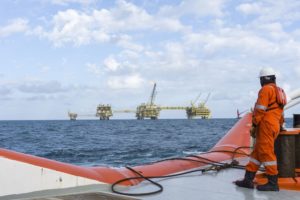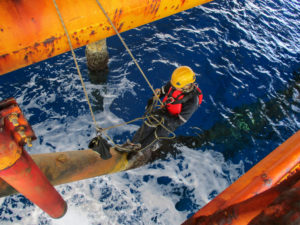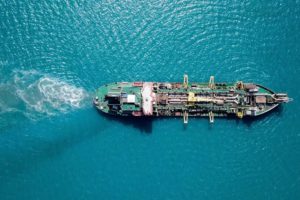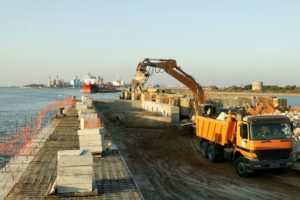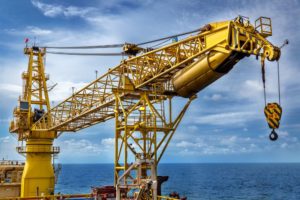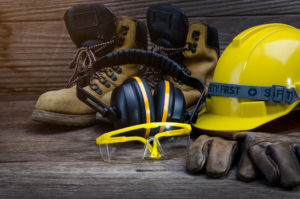Marine construction accidents include any accident that occurs while a worker is performing construction on or over the water. The risk of working over the water is one factor. Another is the type of equipment a worker uses. Accidents are more common in certain areas due to more construction and renovation projects being performed.
Any type of construction job comes with some familiar risks. But when a similar job takes place on water, the risks are even greater. In case of shipyard accidents and injuries, or offshore accidents, workers are often far from medical care.
Maritime construction workers regularly work under strenuous conditions. Depending on the type of project, workers might be situated on a platform that is continuously moving with the water. There’s the risk of fire, explosions, burns, and electrical shocks. Workers might be injured as a result of being struck by a falling object or by being struck with heavy machinery. Falls from heights to hard surfaces or into the water are also common.
For this reason it is important to be aware of your rights and know when to seek legal counsel from an experienced maritime lawyer in Long Beach, California.
Why Are These Marine Construction Accidents Happening?
Marine construction accidents can happen to anyone who works on water. Although the water makes the job riskier, accidents often occur when companies take shortcuts to try and save money. The companies may be negligent because they didn’t follow industry standards. One example is failing to put non-skid coating where workers are doing construction on barges or float stages. Workers often fall due to the slippery surface and get injured.
Details matter a great deal when it comes to working on water. Just walking on a plank or barge can lead to falls. Any time a surface is exposed to water, there is a risk of falling. Oil from some types of equipment can also get spilled onto the surface, making the area where workers walk even more hazardous.
Another common type of accident occurs when materials are lowered into the water. Without properly stabilizing the materials, the water causes them to sway and hit workers nearby. When the workers use a crane to haul materials, failing to secure a tag line can also lead to workers getting hit.
Types of Marine Construction Projects
The types of projects included in marine construction are broad. Some examples include:
Oil Rigs
Working on oil rigs is often an appealing prospect for marine workers who appreciate the hefty salaries. While it’s a lucrative business, working on oil rigs is also a very dangerous business. One of the most common types of accidents that occur is from collapsing decks or work rigs, resulting in workers being struck by debris.
Workers often get injured when they get caught in equipment or machinery that is defective or malfunctioning. There are also slips and falls off the rigs and vehicle crashes that add to the high number of accidents for oil rig workers. The types of injuries these workers sustain vary in degree from finger or fingertip amputations to severe burns and traumatic brain injuries.
Dredges
Dredges are specialized vessels that workers use to excavate the bottoms of shallow coastal water and rivers to clear the way for larger ships. They gather up different types of sediment and then dispose of it in other areas. Dredges are made with long cranes, either in the water or on a shore or platform.
Sometimes workers are injured during transportation to and from the dredges. Working on the dredges often results in crushing injuries to the worker’s arms and hands. A job like loosening blockages in the pipelines is recognized as very dangerous work. The pay is often much higher for these workers because of the known risks for causing serious injuries. Falls and drownings are also common accidents on these vessels.
Bridge Workers
This country’s infrastructure is in dire need of renovation, repair, and replacement services. That means there’s a big chance that more bridge construction accidents will happen in the near future.
Cranes are a common sight at bridge constructions of all kinds. These large pieces of machinery have the potential to malfunction, causing workers to be crushed. There’s also a significant risk of falling from large heights into the water, on the ground, or onto platforms below.
Bridge workers who work over large bodies of water might be knocked unconscious before hitting the water. The impact of the water alone can render them unconscious. When there are significant heights involved, there’s little potential for other workers to rescue them.
Building Jetties
Jetties are structures that project from the land and out into the water to alter the impact of the ocean’s waves. They are used at docks, harbor entrances, rivers, and lagoon outlets.
Dock Workers
Docks are necessary for all types of ships and marine vessels. They are also a worksite for different types of marine workers. They are often filled with lots of people, heavy equipment, and a variety of vehicles. All of these components stay on the move. In an instant, a detail can be overlooked and an accident occurs.
Many accidents on docks involve vehicles. The combination of fast-moving machinery and slow-moving equipment creates a hazardous environment. Other types of marine construction accidents common on docks include crane and winch accidents, electrocutions, fires and explosions, and container accidents. There’s also a high risk of slips and falls.
Too often, an accident occurs due to the negligence of the employer or the facility operators. Important safety precautions are disregarded for the sake of time and/or money. Their negligence in maintaining the dock or following safety precautions makes them liable for your injuries.
Building or Renovating Piers
Like docks, piers are essential to maritime works. They require regular maintenance and replacement of deteriorated materials. Saltwater, pests, and other factors can cause pier damage. In some instances, parts of the structure must be replaced. Other times, the entire pier is torn down, re-purposed, and/or replaced.
High volumes of traffic and activities make piers one of the most dangerous maritime jobs. Some of the most common accidents involve cranes and winches, electrocutions, and fires and/or explosions.
Appropriate safety training is paramount to reducing the risk of accidents and injuries, which can be serious or fatal. Employers are legally obligated to provide adequate training and create a safe working environment.
Piers are common sites of renovations and new construction. Many related injuries occur to workers on planks or on work barges on the water.
Types of Equipment
Winches, cranes, and other heavy equipment often play a part in serious accidents and injuries.
But there’s also the potential for maritime construction workers to get injured from exposure to harmful substances and toxic chemicals. For example, when hydrogen sulfide is used in a small vessel that lacks proper ventilation, the gas can build up and cause serious injury.
Maritime construction workers are always vulnerable to drowning. They may be submerged in water due to falls, vessel sinkings, or being struck by equipment. In nearly every instance, drownings are preventable if the right safety practices are followed, the workers receive adequate training, and the vessels and equipment are properly maintained.
Making Sense of Your Injuries
Many marine construction accidents result in serious injuries to the worker. Maritime law is extremely complex and difficult to navigate. Getting compensation for your maritime injuries is too important to try and do on your own.
Several factors will determine whether you receive compensation. People often think of marine injuries as occurring only at sea. But maritime workers also get injured while performing duties on the shore. Even if your work takes place on land, it may be considered maritime work if it is connected to offshore operations. The Jones Act can protect these maritime workers, too.
The location of the job site and project type make a difference. Was your employer responsible for your injury? Were you working for a contracting company, an oil company, or someone else? Every detail matters when navigating maritime law to get compensation for your injuries. That’s why you need a lawyer who specializes in maritime personal injury cases to help.
What Is the Jones Act?
The Jones Act gives maritime workers the legal right to sue their employer for compensation for injuries resulting from negligence. Examples of employer negligence include, but are not limited to, a failure to:
- provide proper safety training prior to allowing workers to perform duties;
- provide a seaworthy vessel;
- perform timely checkups on equipment and parts;
- apply non-skid surfaces to vessel decks;
- repair malfunctioning equipment and parts;
- place warning signs in hazardous areas;
- provide workers with the proper safety gear
The Jones Act provides compensation in three areas: loss of earnings, medical expenses, and pain and suffering. Under some circumstances, punitive damages may also apply. The court awards these damages in addition to the compensation to punish the defendant.
Loss of earnings covers current earnings and those you are unlikely to earn in the future as a result of your injury. Employee benefits 401K also apply. Present and future medical treatment is also covered. Predicting the cost of future medical treatment and the potential earnings lost is difficult. An attorney who specializes in maritime law can calculate the amount of compensation you will need for your future.
Not only does the Jones Act pay compensation to marine construction workers; it covers everyone who works aboard the vessel. This includes cooks, barbers, stewards, entertainers, and more.
A Note on the Longshore and Harbor Workers’ Compensation Act
The LHWCA is a federal law that provides compensation to employees who become disabled from employment on the navigable waters. The compensation includes medical care and vocational rehabilitation services, along with survivor benefits to the worker’s dependents.
There are similarities and exclusions that set the Longshore Act and the Jones Act apart. An experienced maritime lawyer at Naylor Law can advise you on the type of benefits you qualify for. It’s possible to qualify for both.
Why You Need a Maritime Personal Injury Lawyer
Though marine construction workers are well aware of the accidents they may be at risk of every day, many never plan for what to do if they become unable to work. Most don’t take the time to learn about their rights until after an injury happens. They may falsely believe that there is nothing they can do to help their situation.
Like work injuries that take place on land, many maritime workers have their claims denied. At a time when their debt for medical care keeps growing, they find themselves without any source of income. Getting compensation starts with making the right choices from the time of the accident.
Don’t make the mistake of not reporting your injury to your employer. You need to create a record of the accident and injury before you leave work. Otherwise, your employer might claim that you were injured somewhere else.
Collect evidence to support your claim. Use your cell phone to take photographs of your injuries and the setting where the accident occurred. Collect contact info for any witnesses who saw the accident or your injuries.
Get immediate medical attention. This is important for your well-being as well as for your claim. If your injuries don’t require medical care, your employer will argue that it wasn’t that serious.
Take all of the evidence you have to a maritime personal injury lawyer, who has handled many cases like yours and knows what it takes to make your case and get a fair settlement for your injury. Other lawyers don’t have the same degree of knowledge about maritime law.
A good lawyer will work with you and explain the process every step of the way. He or she will explain your rights within the law and the process for getting the compensation you deserve. You work in a high-risk industry by choice. That doesn’t mean you have to live with the consequences of someone else’s neglect.
If your claim has already been denied, there is still hope. Don’t wait any longer to get the professional legal support you need. Contact the Law Offices of Charles D. Naylor to schedule your free case evaluation. You aren’t alone. We have gotten many large settlements and verdicts for our clients. We’ll get the best possible outcome for you, too!

